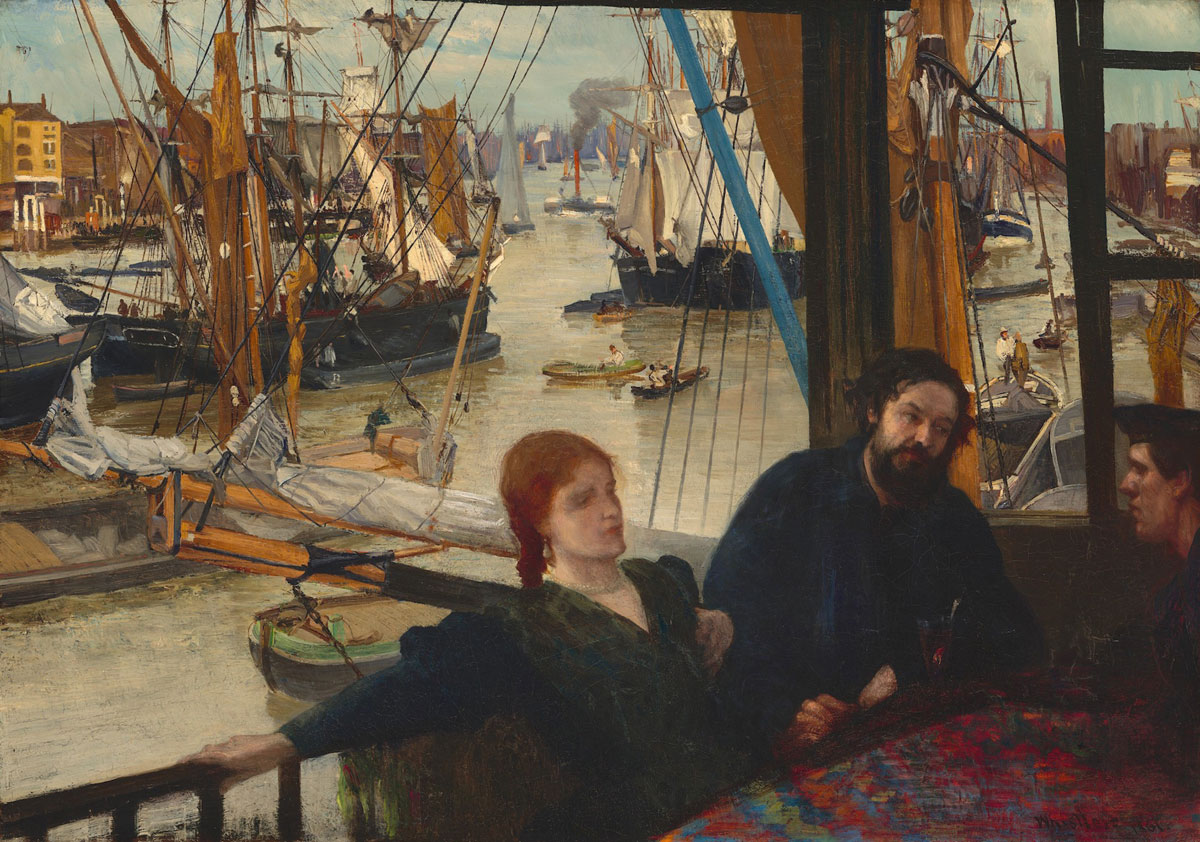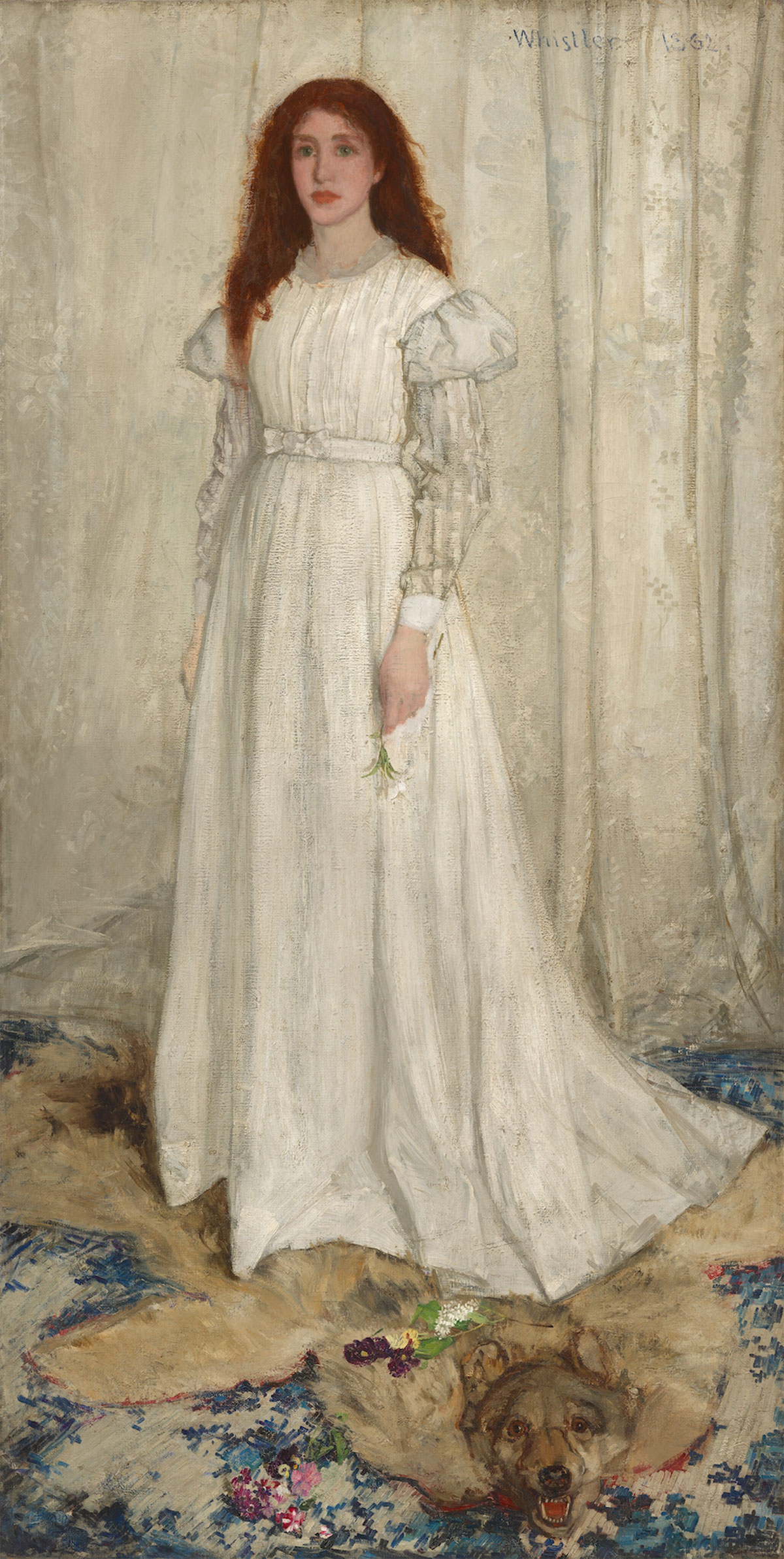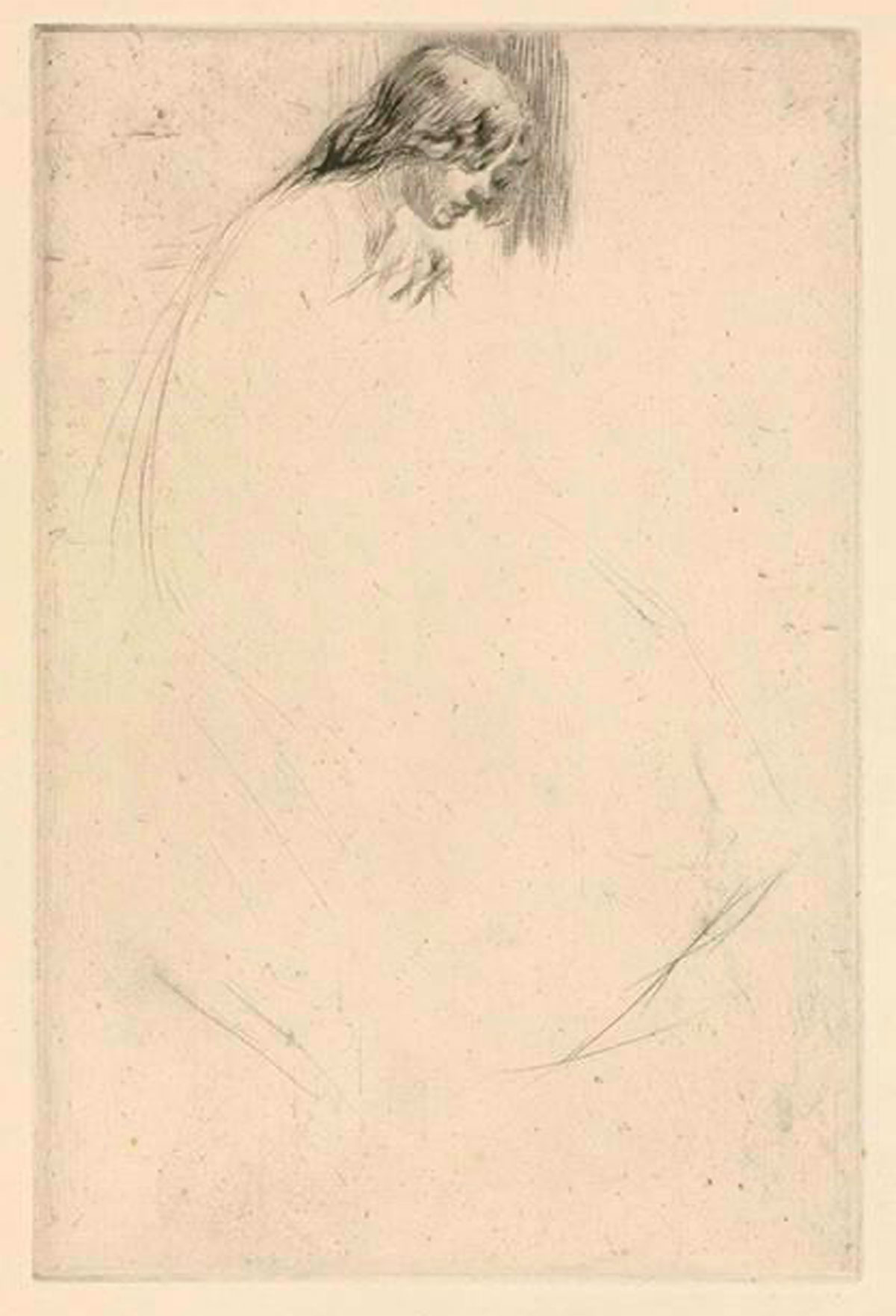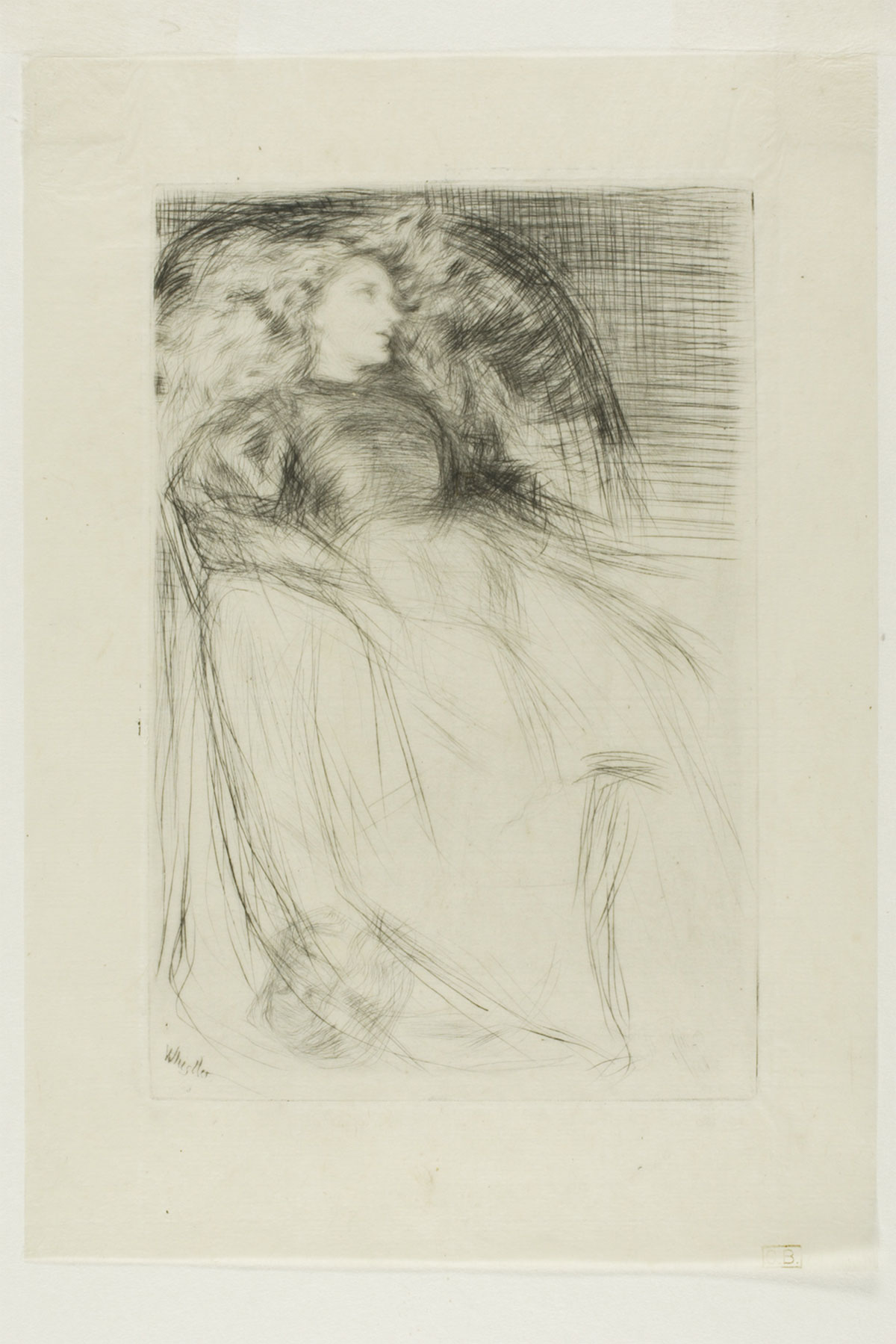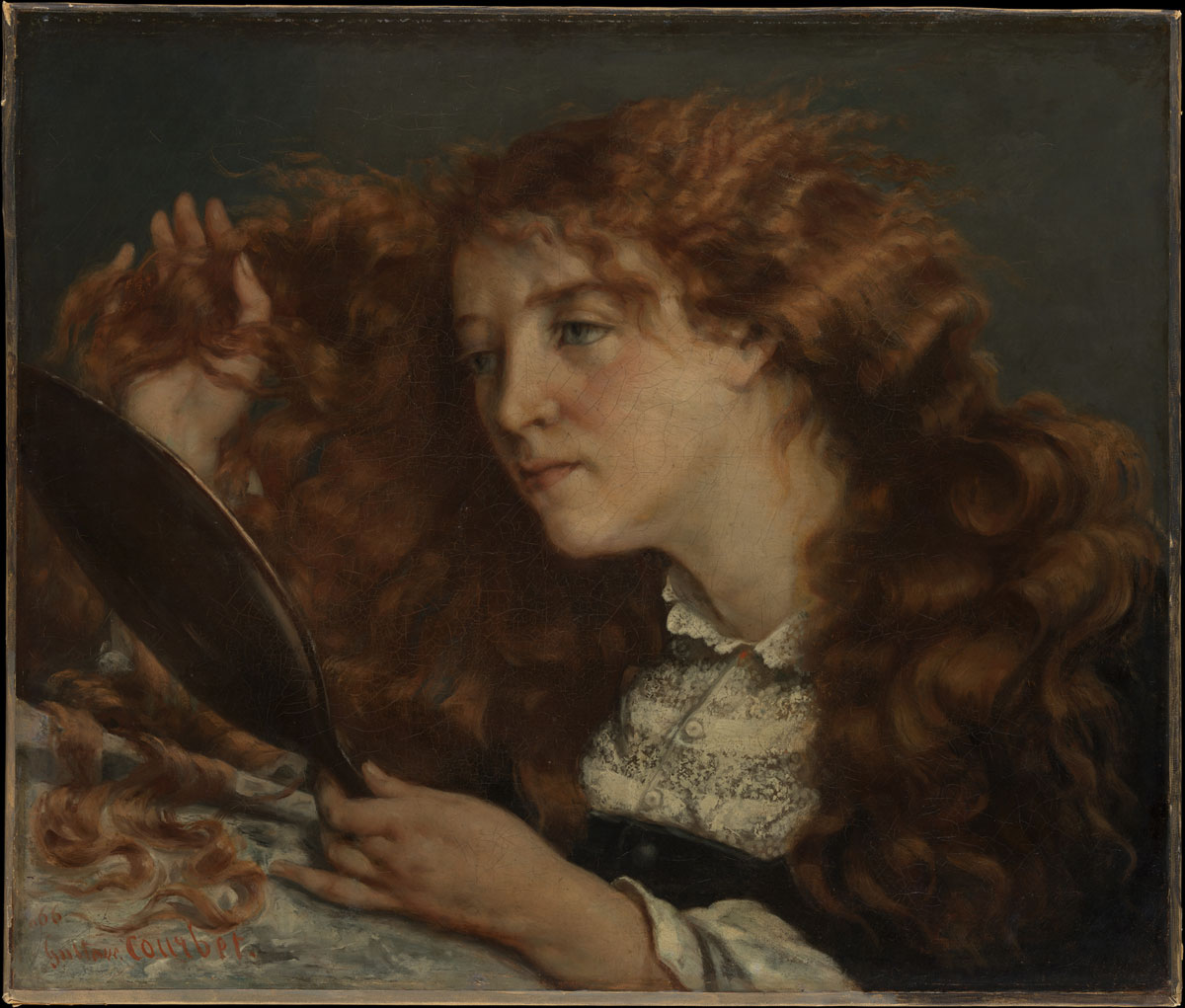Greeting you on entering ‘Whistler’s Woman in White: Joanna Hiffernan’ at the Royal Academy (26 February–22 May 2022) is not ‘Whistler’s woman’ but the man himself in photographic form blown up, on a big panel, from his carte de visite (by Carjat et Cie, Paris, c. 1864). No photograph of Joanna ‘Jo’ Hiffernan is known. Whistler’s white veil is never quite lifted from Jo’s face — almost never — but the admirable achievement of the exhibition is to give us, by the time we have left (and started to read the exhibition catalogue), the beginnings of a coherent outline of the human being in the second part of the title: the impoverished Limerick-born Victorian woman Jo. Jo, who we never quite encounter inside the exhibition, met Whistler in 1860 and became his model, lover, inspiration, assistant, and named sole heir, until her premature death in 1886 at the age of forty-four. They did not marry. Whistler was five years older and died in 1903. As the exhibition reveals, Jo also became a participant in the ‘Woman in White’ phenomenon in Victorian culture, thanks to Whistler’s readiness to capitalize on the popularity of the sensation novel of that name. In this guise Jo has a legacy of a sort reaching long into late nineteenth-century English, Belgian, and Viennese painting. An excellent essay in the catalogue by Aileen Ribeiro, contextualizing the white dress in late nineteenth-century English and French fashion, further traces Hiffernan’s impact, as ‘woman in white’, on French Impressionism.1 Jo gains yet another face in the penultimate room of the exhibition, in three similar and perplexing close-up portraits by Whistler’s friend Gustave Courbet: Jo, the Beautiful Irish Girl (c. 1866/68), Jo, the Irish Woman (c. 1866/68), and Jo, la belle Irlandaise (1865–66).
On arriving in mid-Victorian London, Whistler seemingly fell under the spell of the charismatic Dante Gabriel Rossetti. Opposite the entrance hangs Rossetti’s Ecce Ancilla Domini! (1849–50), in which Mary, in a white dress, is startled from her stark white bed by a golden-haired Gabriel, wearing a white tunic and, apparent from a strip of bare hip, nothing underneath. The archangel points a white-flowering lily stem at the crease in Mary’s beautifully composed drapery and towards her womb within and, further right, towards a hanging strip of shockingly red fabric onto which Mary, we surmise, has been embroidering a lily with three white flowers in unconscious anticipation of her cosmic destiny. Translating the stuff of Academic art into life, Rossetti brings a sort of humanity to the figure of Mary, who is a mere adolescent girl sitting up in bed, her red hair in some disarray. She is depicted here at the Annunciation, just after the moment imagined by Rossetti in his poem inscribed on the frame of The Girlhood of Mary Virgin (1849), relating Mary’s domestic adolescence:
Thus held she through her girlhood; as it were An angel-watered lily, that near God Grows, and is quiet. Till one dawn, at home She woke in her white bed, and had no fear At all, — yet wept till sunshine, and felt awed.2
On the opposite wall to Ecce hangs Whistler’s Wapping (1860–64) (Fig. 1). Jo models an unimpressed-looking red-haired woman sitting with two men (one modelled on Alphonse Legros) on a balcony in a seedy Bermondsey pub overlooking a Thames scene filled with ships, sails, sailors, rigging, enterprise, empire, and murk. In depicting the life of the ‘lower’ echelons of his contemporary social reality, Whistler’s painting might be described as ‘realist’. A suggestion of sexual transaction hovers around the foreground, as Whistler himself remarked in a letter to Henri Fantin-Latour.3
So we have here, on opposite walls, the two archetypes of Victorian femininity depicted by Rossetti and Whistler, respectively: innocence and fallenness, ‘virgin’ and ‘whore’. If Whistler’s Aestheticist work was, in a few years, to render these moralizing categories indeterminate, the exhibition ingeniously proposes that some of the groundwork for this was laid by Rossetti himself: that Pre-Raphaelitism gave Whistler some of the key ingredients for his Aestheticism. Rossetti’s virgin translates art into life (embroidery into destiny), which is then translated into painting. Arguably, Whistler will take up and extend these paradoxes into extremely ambiguous representations of women.4 This exhibition has ambition and substance, then. Unfortunately, Ecce Ancilla Domini! does not look its best where it is hung. It is swallowed up in the long, rectangular room, or it could be the lighting on the days I visited. Gabriel’s pale, almost white skin comes across on his right arm sadly grey.
In the second room, the ‘inner sanctum’ of the exhibition, hang Symphony in White No. 1: The White Girl (1861–63, 1872) (Fig. 2) and Symphony in White No. 2: The Little White Girl (1864), retrospectively retitled after the exhibition of Symphony in White No. 3 (1865–67) at the Royal Academy. All three depict Jo: she is the figure sitting on the sofa in Symphony 3. Fatefully, Symphony 1 was turned down by the Royal Academy in 1862 and Whistler exhibited it in Morgan’s Gallery on Berners Street, north of Oxford Street later that year. (Having also been rejected by the Salon in Paris, it was exhibited in the Salon des Refusés in 1863.) The picture was advertised at Morgan’s Gallery as Whistler’s ‘Woman in White’, riding on the coat-tails of Wilkie Collins’s The Woman in White (serialized 1859–60). Whistler, a gifted self-publicist, managed to capitalize on the association while maintaining that the picture had absolutely nothing to do with the sensation novel, as related by displays in the third room. The exhibition is identifying, then, a collision in Whistler’s Symphony 1 between an iconography of a female figure in white in dialogue with Rossetti, on the one hand, and resonance with the Collins sensation novel, on the other. The exhibition is subtle yet convincing in telling a story about how this collision in Whistler feeds back into Victorian culture and a wide-ranging nineteenth-century woman-in-white phenomenon. Symphony 1 looks eerie, unworldly, and beautiful; the exhibition room intimate and un-echoey. The figure modelled by Jo has large, green eyes. Her red hair falls down onto her white cambric dress, which has a bodice with narrow vertical pleats, a silk chiffon frill on the neckline, puffs at the top of the arms, sleeves of grey-and-white striped fine muslin, and starched, white cuffs. The figure stands in front of a patterned white muslin curtain; the white-on-white effect is effervescent. She stands on a bearskin rug, its roar dumb and eyes pitiful. Around the bear’s head between the rug and the carpet, red patches that suggest blood (but might also allude to Rossetti’s embroidery) almost seep into the patterned carpet beneath. Innocence, maturity, conquest, maybe even predation, violent passions becalmed, or interiorized — narrative options proliferate and are at once blocked. Symphony 2 looks just as resplendent in all its ambiguity. It is interesting to have a handwritten manuscript of A. C. Swinburne’s ekphrastic poem, inspired by Whistler’s picture, rather than just a wall text showing the familiar verses, including this description of the figure modelled by Jo:
Glad, but not flushed with gladness, Since joys go by; Sad, but not bent with sadness, Since sorrows die; Deep in the gleaming glass She sees all past things pass, And all sweet life that was lie down and lie.5
In Symphony 2 Whistler depicts a liminal realm that hovers between reality and illusion, drawing room and studio, past and present, fate and choice, ‘virgin’ and ‘whore’. Addressing the role of temporality explicitly in Symphony 3, Caroline Arscott has explored Whistler’s stripping away and relayering of whites as mimicking the operations of memory.6 Time seems key to all three. Interestingly, Symphony 3 looks surprisingly small (51 × 76.5 cm), particularly next to the large Symphony 1 (213 × 107.9 cm) though it is the same size as Symphony 2, just differently oriented (76.5 × 51.1 cm). To see all three together is instructive, and a treat. I will return to this inner sanctum at the end of the review.
In the next room we find two series of different drypoint prints of Jo: Jo with Bent Head (1861) and Weary (1863) (Figs. 3, 4). The first of these is very beautiful. In contrast to the Symphonies, which build up layers of white that seem to conceal obscure meanings in their creamy depths, the ‘white’ of these prints is the unprinted page, which, especially in the rightmost two of the four Bent Heads, composes, together with a few lines, the broad outline of the dressed figure. Her face is detailed — this is Jo the beloved, Jo as she was at home — yet we are still in some sense with Rossetti here, not so much with the girl cowering back on her bed in Ecce as with the domestically dutiful girl from The Girlhood of Mary Virgin, head slightly bent, hard at work embroidering her red fabric with the white lily. And in the Whistler, does the indeterminate pencil-like drypoint needlework beneath her face suggest Jo’s hands clasped in prayer? We perceive here, perhaps, the stirrings of a religion of art, an Art for Art’s Sake, with Whistler’s woman in white as the page, as the unincised plate, perhaps as the medium of creativity itself, sacred, cherished, ambiguous. The second Jo with Bent Head from the left is clouded in ink. Shadow, the depth of blackness, maybe death, hover around Whistler’s woman in white.
With the five versions of Weary we move in and out of darker and lighter states, or realms (working from the rightmost into the corner, 5 is the faintest, 4 a bit dark, 3 and 2 medium, 1 dark again, and my favourite). ‘Ghostly’ would be an understatement. The figure of Hiffernan appears in an armchair, caught as if in the process of being composed (or is it uncomposed?) by clumps, strands and webs of lines, and inky shadow. Lines sweep around the torso, over and under a gorgeous but inhuman sheen, down her arms, springing quickly from her wrists, her hands ‘disappearing’ into the ether. The hair seems to contain all of Jo’s energy: arrayed against the armchair behind, it is a wild corona flickering with electric charge.
Sacred, cherished, ambiguous, sinister even, a medium to another world — to my terms for the woman in white functioning in Whistler’s developing Aestheticism we must also add ‘orientalist’. Like Rossetti, who really does haunt this exhibition, Whistler collected artefacts of Japanese and Chinese origin (much of the Victorian public were unable to distinguish between the two). The robe in Purple and Rose: The Lange Leizen of the Six Marks (1864) is ravishing. Jo looks like a different person here (again). Hanging to the right of this fourth room are some Utagawa Hiroshige woodblock prints, including one for a fan, The Banks of the Sumida River (1857), made for a European market. It is interesting to see these prints in relation to Symphony 2, in which an unsettling prop-like quality clings to the Hiroshige fan, red lacquer bowl, and blue-and-white vase. I would have liked to have been informed more about the paper types that were so deliberately used by Whistler in printing, or to have seen a contribution in the exhibition catalogue on this topic. Weary, for example, is printed on different Asian papers.
Then we come to Courbet’s three paintings of Jo looking (intently? anxiously?) into a handheld mirror, her hand running through her red hair. The catalogue proposes that the version owned by the Metropolitan Museum of Art (Fig. 5), showing Jo with a more furrowed brow, is the much admired portrait from which Courbet produced three sale copies (only one not exhibited here), rather than the softer canvas owned by Stockholm’s Nationalmuseum, which is sometimes claimed as the original.7 In any case, in these pictures Courbet is depicting Whistler’s Venus, the archetype of his friend’s Aestheticism. With this thought, an unpleasant notion of men (Whistler, Courbet, Courbet’s patrons) passing around Jo’s image comes to mind; it is as though Jo is not in control of her own image. And yet Jo’s presence in the three Courbets almost has the stoicism of Swinburne’s description of the figure in Symphony 2, and even of Rossetti’s description of Mary. In proposing a train of associations running through Rossetti, Whistler, Swinburne, and Courbet, the exhibition conjures pictures within pictures. Finally, with the Courbets, we also see Jo regarding — that is, almost picturing — herself. The question of agency is subtly problematized, though left unanswered by the exhibition.
The effect of having these three slightly different portraits of Jo by Courbet hanging on the far wall of this room is peculiar and memorable, but the way the portraits hang opposite Whistler’s Sea and Rain (1865) and next to Courbet’s seascapes is a little jarring (Jo, Whistler, and Courbet stayed together at Trouville, Normandy). Whistler’s and Courbet’s seascapes are very different, and these differences can be thought about in terms of temporality. Sea and Rain evanesces into the canvas, like the shadowy figure on the shore into the sand; the picture almost becomes a memory of itself. Evanescence is, it must be said, less of an issue in Courbet’s work. More thickly built up and solid, each of his seascapes suggests an extended moment, elongating the present somehow. The final room has some later ‘women in white’ paintings, responding (in part) to Whistler, including John Everett Millais’s A Somnambulist (1871), in which a woman wanders perilously close to a cliff edge in her white night gown. Millais brilliantly transmogrifies all the otherworldliness of Whistler’s Symphonies back into a functioning narrative framework more typical of nineteenth-century British painting. The last room also looks beyond British painting, tracing Whistler’s woman in white into work by Fernand Khnopff, Gustav Klimt, and Albert Herter.
By naming her and outlining for her a history, Jo’s ambiguous participation as model and maybe even muse starts to become visible. This seems to be the main work of the exhibition, and it is good work, following in the wake of the recent ‘Pre-Raphaelite Sisters’ exhibition (National Portrait Gallery, 2019–20). Looked at another way, of course, Whistler, in awe of Rossetti, obtains his own redhead ‘stunner’ plucked from the working class, fashions her into his woman in white, and lives a Pre-Raphaelite life all of his own. Such objections can and should never be banished, but a painting hanging in the inner sanctum left me with a different perspective. Started after Symphony 1 and abandoned a few weeks later, A White Note (1862) depicts Hiffernan in the Pyrenees, where she and Whistler were staying. Dressed in a low-cut, white blouse showing streaks of blue through the broad white strokes, and a skirt or morning robe, she clasps her hands, her right elbow propped up. She is looking over her right shoulder at a slightly stony sky and blocked out landscape. A green steam engine is moving, barely visible, through the landscape, these greens complementing her brown-red hair. Perhaps it is the unfinishedness of the picture combined with the allusion in the title to the type, but I got from this touching painting, hung at the heart of the exhibition, a sense of the real person behind the veil of Whistler’s woman in white.
Notes
- Aileen Ribeiro, ‘Fashioning White in the Work of Whistler and His Contemporaries’, in Margaret F. MacDonald and others, Whistler and the Woman in White: Joanna Hiffernan, exhibition catalogue (New Haven: Yale University Press, 2022), pp. 157–66. [^]
- G. D. Rossetti [sic], ‘The Girlhood of Mary Virgin’, in Catalogue of the Association for Promoting the Free Exhibition of Modern Art, Gallery, Hyde Park Corner (London: Bradley, 1849), p. 18 <http://www.rossettiarchive.org/docs/n8640.a8.rad.html#p18> [accessed 12 July 2022]. [^]
- Whistler to Fantin-Latour, January/June 1861, quoted in Margaret F. MacDonald, ‘Whistler and the Woman in White’, in Margaret F. MacDonald and others, pp. 11–13 (p. 12). [^]
- A related point is made by Charles Brock in his essay in the exhibition catalogue, where he points out that ‘Whistler and Hiffernan later defied the expectations of their audience when they mixed realism and aestheticism in their version of a grand manner portrait’ — i.e. Symphony in White No. 1: The White Girl (1861–63, 1872) — ‘just as Rossetti unsettled viewers when he wed a stark realism to the spiritual idealism of his theme’ in Ecce Ancilla Domini!. See Charles Brock, ‘A Short History of the Woman in White’, in Margaret F. MacDonald and others, pp. 171–91 (p. 180). Brock seems to mean more than ‘naturalism’ in saying that Rossetti gave the spiritual idealism a stark reality: stripped of Academic grandeur, Mary is but an ordinary girl. Whistler’s own realism is palpable in his representations of the social reality he encountered in working-class London, like the superb drypoint Ratcliffe Highway (1859/61) also hung in the exhibition’s first room. Whistler’s realism clearly informed his Aestheticist works, and even the works often described as Impressionist, such as the Nocturnes of the Thames. This complicated issue was not tackled head on in the exhibition, and it deserves further consideration. [^]
- Algernon Charles Swinburne, ‘Before the Mirror’, in Poems and Ballads (London: Camden Hotten, 1866), p. 151. [^]
- Caroline Arscott, ‘Whistler and Whiteness’, in The Colours of the Past in Victorian England, ed. by Charlotte Ribeyrol, Cultural Interactions: Studies in the Relationship between the Arts, 38 (Oxford: Lang, 2016), pp. 47–70. [^]
- Margaret F. MacDonald, ‘Joanna Hiffernan and James McNeill Whistler: An Artistic Partnership’, in Margaret F. MacDonald and others, pp. 15–31 (pp. 25–26). [^]

